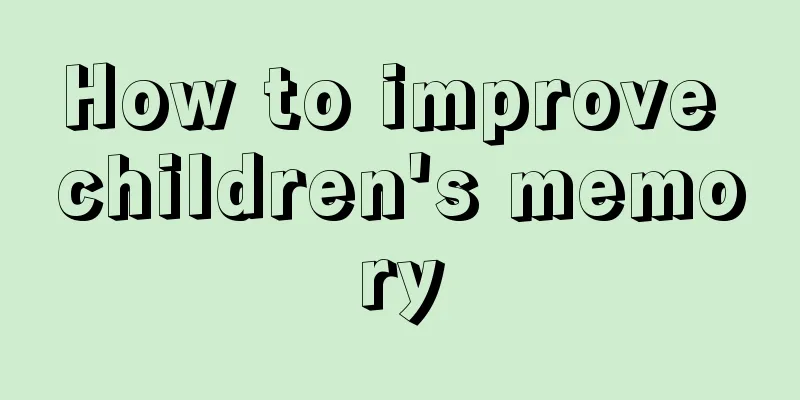What should I do if my child has a fever in the middle of the night?

|
Fever is a very common phenomenon. Many children will develop fever due to catching a cold. If a child has a fever in the middle of the night and parents are unable to take their child to the doctor in time, then they must take certain measures to cool the child down to prevent the child's body temperature from rising further and affecting his or her brain development. Here is how parents can deal with their children having a fever in the middle of the night. 1. Measuring body temperature Parents should not panic if their children have a fever at night. The first thing to do is to test the child's temperature with a thermometer to see the extent of the child's fever, and then take corresponding measures. 2. Physical cooling: suitable for body temperature below 38.5 degrees (1) Drink more warm water, vegetable juice and fruit juice. Let your baby drink more water and replenish body fluids. This is the most basic method of reducing fever. It is very effective and practical and suitable for all babies with fever. Do not give your baby cold water, but warm water, because fever in babies is often accompanied by gastrointestinal symptoms and cough, and drinking cold water will aggravate these accompanying symptoms. (2) Warm water bath, that is, wipe the whole body with a warm water towel. This is a great way to cool down any baby who has a fever. The water temperature is more suitable at 32-34 degrees, and each wiping time should be more than 10 minutes. The key areas to wipe are the skin folds, such as the neck, armpits, elbows, groin, etc. (3) Warm water bath: The water temperature should be about 3-4°C lower than the patient's body temperature, and each bath should last for 5-10 minutes. Many parents think that babies should not be bathed when they have a fever. In fact, on the contrary, giving babies a warm bath can help cool them down. A warm bath is suitable for all babies with a fever. (4) Low-temperature chamber method: Place the sick child in an environment with a room temperature of approximately 26°C to allow the body temperature to slowly drop. In order to allow the skin to come into contact with the outside air and help cool down, people need to wear less clothes. If conditions permit, use air conditioning to lower the room temperature. This method is suitable for babies under 1 month old, especially in summer. Just open the baby's clothes and put him in a cool place, his body temperature will slowly drop. If your baby has chills and shivering when having a fever, you should not use the low-temperature chamber method. (5) Cooling patches: Cooling patches are a new product in recent years and are very popular. However, their cooling effects are generally average and not as good as advertised. Putting a patch on the baby's forehead will make the baby's head feel more comfortable and the parents will feel more at ease too. It should be beneficial and harmless. (6) Ice compress: You can use a small amount of ice compress appropriately and apply ice or cold compress to the baby's forehead, sides of the neck, armpits, groin and other large blood vessels. But be sure to wrap a layer of cloth around the ice bag to prevent local frostbite on the baby's skin, and babies under 6 months old should not be given ice compresses. There is still much controversy about the pros and cons of this approach. It is generally believed that ice compresses do more harm than good, because they may cause the capillaries in the baby's skin to contract, hindering heat dissipation and causing the body temperature to be higher. Especially if accompanied by chills or shivering, ice compresses should not be used. (7) Alcohol bath: This method has been abandoned. Babies' skin is very thin and alcohol is highly permeable, so it may be absorbed into the blood through the skin. Moreover, alcohol baths can also irritate the skin, causing capillaries to contract, hindering heat dissipation, and causing the body temperature to be higher. 3. Take antipyretics under the guidance of a doctor The home should prepare some antipyretic drugs that are suitable for children and have high clinical safety. If the baby's temperature is still over 38.5℃ after physical cooling treatment, medication should be used to reduce the fever. If the child's fever does not go down after taking antipyretics and his mental state is not good, he should go to the hospital immediately to avoid delaying the baby's condition and causing other complications. |
<<: Recipes for two and a half year old babies
>>: 5-year-old baby's intellectual development
Recommend
What to do if your baby cries during the day
Everyone hopes that their baby can grow up health...
What to do if a teenager has a hunchback
Once a teenager is found to have hunchback, it sh...
Can a five-month-old baby eat? It is important to know how to eat correctly
If the baby is five months old, parents can add s...
How to make complementary food for a one year and three month old baby?
When the baby is one year old, his body basically...
How to prepare baby milk powder
Infant formula powder is a very common drink. Man...
Grandma's words almost cost the baby's life
According to media reports: On the second floor o...
What should I do if my child has a painful tongue ulcer?
Tongue ulcers are a very common phenomenon. This ...
How to remove baby's scalp cradle cap
The cradle cap on the baby's head is just a p...
Why does a one-month-old baby fart smell bad?
What worries people the most now is the newborn b...
Is it good or bad for children to use pillows?
A pillow is a kind of bedding that people often u...
What should I do if my child has laryngitis and cough?
Pharyngitis is a disease that can occur in people...
Will the baby's skin peeling after being burned leave scars?
Accidents are often uncontrollable. Many parents ...
What to do if your child has a fever
Let us first understand that fever is the phenome...
How many months does the baby grow milk teeth
When babies reach a certain stage of development,...
White and sticky nasal discharge
Snot is a kind of excretion from the nose. Someti...









